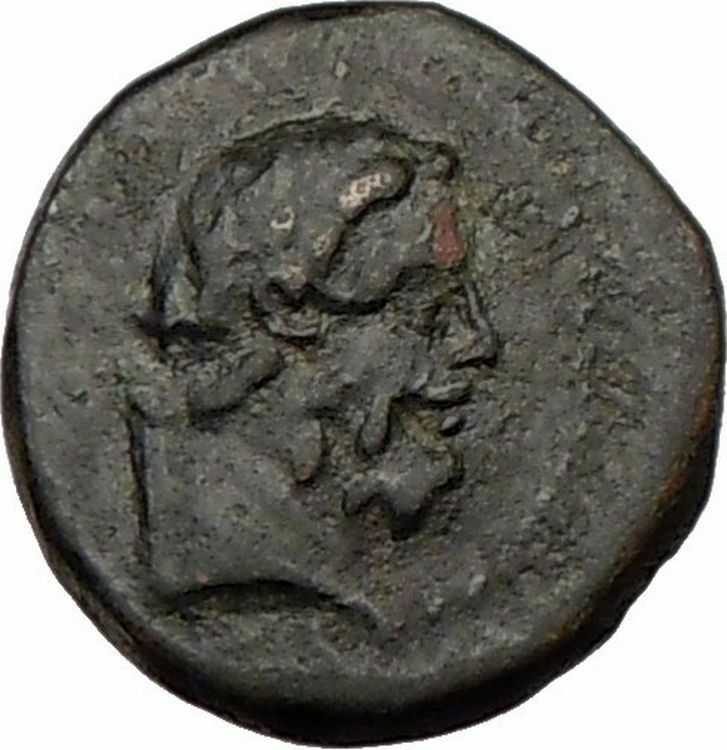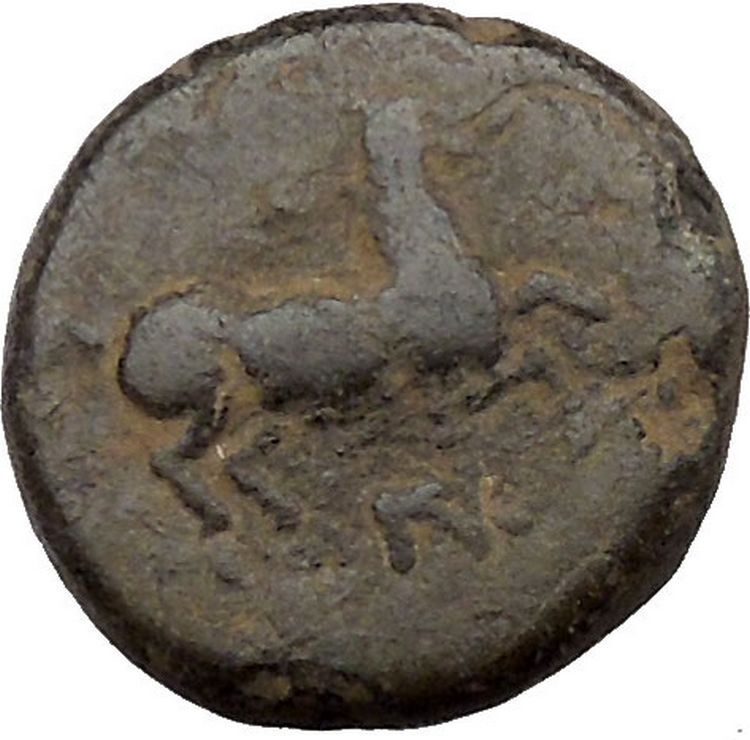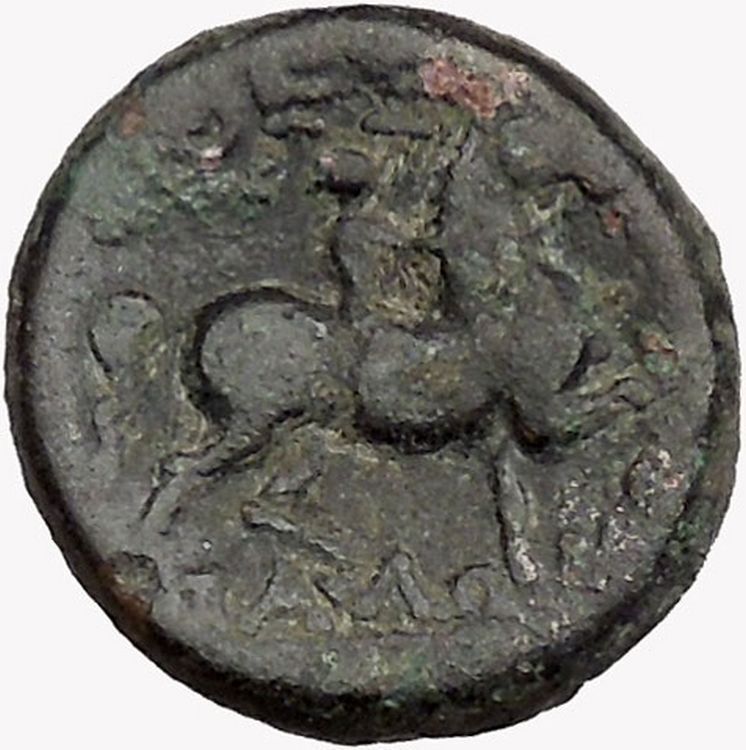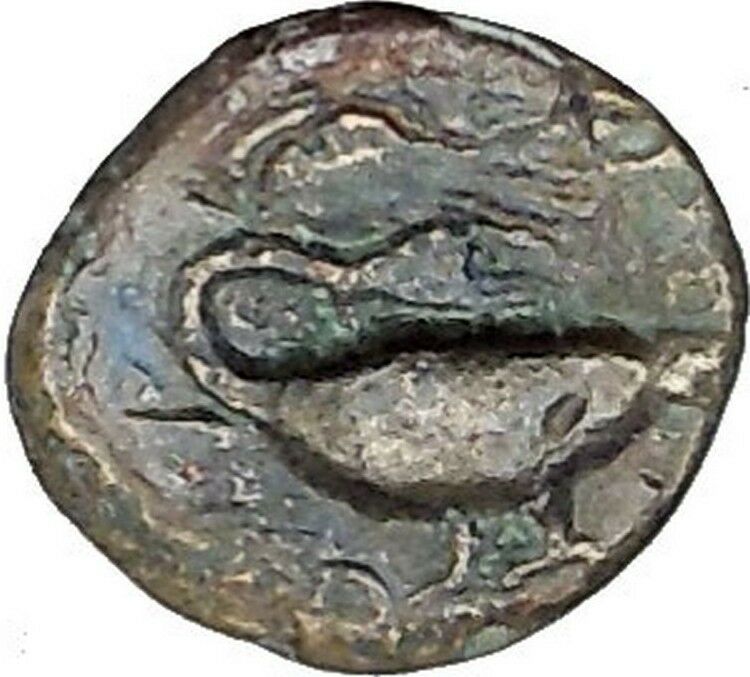|
Greek city of Laranda in Lycaonia
Silver Obol 10mm (0.51 grams) struck circa 324/3 B.C.
Reference: Göktürk 82; SNG Levante 223; SNG Aul. 5422 (var.); SNG BN 447
Baaltars seated left, holding grain ear, grape bunch, and sceptre.
Forepart of wolf right; inverted crescent above; all within circular border of
pellets.
You are bidding on the exact
item pictured, provided with a Certificate of Authenticity and Lifetime
Guarantee of Authenticity.
Karaman is a town
in south central Turkey
, located in
Central Anatolia
, north of the
Taurus Mountains
, about 100 km (62 mi) south of
Konya
. It is the capital district of the
Karaman
Province
. According to 2000 census, the
population of the province is 231,872 of which 132,064 live in the town of
Karaman. The district covers an area of 3,686 km2 (1,423 sq mi), and
the town lies at an average elevation of 1,039 m (3,409 ft). The Karaman Museum
is one of the major sights.
Etymology
The town owes its name to Karaman Bey who was one of the rulers of the
Karamanid
dynasty. The former name Laranda
which in turn comes from the
Luwian language
Larawanda, literally
“sandy, a sandy place”.
History
In ancient times Karaman was known as Laranda (Λάρανδα in
Ancient greek
). In the 6th century BC it came
under
Achaemenid
rule until 322 BC, when it was
destroyed by Perdiccas
, a former general of Alexander the
Great, after he had defeated Ariarathes, king of Cappadocia. It later became a
seat of Isaurian pirates. It belonged to the
Roman
and later
Byzantine Empire
until it was captured by the
Seljuks
in the early 12th century. Karaman was
occupied by
Frederick Barbarossa
in 1190 . In 1256, the
town was taken by the
Turkish
bey
Karamanoğlu Mehmet Bey
and was renamed Karaman
in his honour. From 1275, Karaman was the capital of the Karaman Beylik (and
later
Ottoman
province) of
Karamanid
.
In 1468 Karamanid was conquered by the Ottomans and in 1483 the capital of
the province was moved to
Konya
. Karaman has retained ruins of a
Karamanid castle and some walls, two
mosques
and a
Koran
school (madrasah)
from that age. An exquisite
mihrab
from a
mosque
from Karaman can now be found in the
Çinili Pavilion
near the
Archeology Museum
in
Istanbul
.
There was a
Roman Catholic
titular see
for the city.
The poet
Yunus Emre
(c. 1238-1320) resided in Karaman
during his later years and is believed to lie buried beside the Yunus Emre
Mosque. A small adjacent park is adorned with quotations from his verse, many of
them unfortunately
graffiti
-splattered. In 1222, the
Sufi
preacher Bahaeddin Veled arrived in town
with his family, and the Karamanoğlu emir built a
medrese
to accommodate them. Veled’s son was
the famous
Mevlana
Jelaluddin Rumi
, who married his wife, Gevher
Hatun, while his family was living in Karaman. It was here, too, that Rumi’s
mother died in 1224. She was buried, along with other family members, in the
Aktekke Mosque (also known as the Mader-i Mevlana Cami), which Alaeddin Ali Bey
had built to replace the original medrese in 1370.
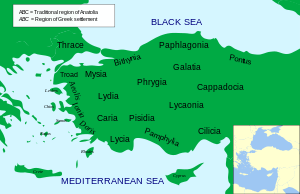
Lycaonia
was a large region in the interior of
Asia Minor
, north of the
Taurus Mountains
. It was bounded on the east by
Cappadocia
, on the north by
Galatia
, on the west by
Phrygia
and
Pisidia
, while to the south it extended to the
chain of Mount Taurus, where it bordered on the country popularly called in
earlier times Cilicia
and in the Byzantine period
Isauria
; but its boundaries varied greatly at
different times. The name is not found in
Herodotus
, but Lycaonia is mentioned by
Xenophon
as traversed by
Cyrus the Younger
on his march through Asia.
That author describes
Iconium
as the last city of Phrygia; and in
Acts
14:6
Paul
, after leaving Iconium, crossed the
frontier and came to
Lystra
in Lycaonia.
Ptolemy
, on the other hand, includes Lycaonia
as a part of the province of Cappadocia, with which it was associated by the
Romans for administrative purposes; but the two countries are clearly
distinguished both by
Strabo
and Xenophon and by authorities
generally.
Etymology
There is a theory that the name “Lycaonia” is a Greek-adapted version
(influenced by the Greek masculine name
Lycaon
) of an original Lukkawanna, which
would mean “the land of the
Lukka
people” in an old
Anatolian
language related to
Hittite
.
Geography
Lycaonia is described by
Strabo
as a cold region of elevated plains,
affording pasture to wild asses and to sheep; and at the present day sheep
abound, but asses are practically unknown.
Amyntas
, king of
Galatia
, to whom the district was for a time
subject, maintained there not less than three hundred flocks. It forms part of
the interior tableland of
Asia Minor
, and has an elevation of more than
1000 meters. It suffers from want of water, aggravated in some parts by
abundance of salt in the soil, so that the northern portion, extending from near
Iconium
to the salt lake of
Tatta
and the frontiers of Galatia, is almost
wholly barren, only small patches being cultivated near Iconium and the large
villages. The soil, where water is supplied, is productive. In ancient times
great attention was paid to storing and distributing the water, so that much
land now barren was formerly cultivated and supported a large number of cities.
The plain is interrupted by some minor groups of mountains, of volcanic
character, of which the
Kara Dagh
in the south, a few miles north of
Karaman
, rises to 2288 meters, while the
Karadja Dagh
, north-east of it, though of
inferior elevation, presents a striking range of volcanic cones. The mountains
in the north-west, near Iconium and
Laodicea Combusta
, are the termination of the
Sultan Dagh
range, which traverses a large part
of Phrygia.
History
The Lycaonians appear to have been in early times to a great extent
independent of the
Persian empire
, and were like their neighbors
the Isaurians a wild and lawless race of
freebooters
; but their country was traversed by
one of the great natural lines of high road through Asia Minor, from
Sardis
and
Ephesus
to the Cilician gates, and a few
considerable towns grew up along or near this line. The most important was
Iconium
, in the most fertile spot in the
country, of which it was always regarded by the Romans as the capital, although
ethnologically it was Phrygian. It is still called
Konya
, and it was the capital of the
Seljuk
Turkish empire for several centuries. A
little farther north, immediately on the frontier of Phrygia, stood
Laodicea Combusta
(Ladik),
surnamed Combusta, to distinguish it from the Phrygian city of that name;
and in the south, near the foot of Mount Taurus, was
Laranda
, now called
Karaman
, which has given name to the province
of
Karamania
.
Derbe
and Lystra, which appear from the
Acts of the Apostles
to have been considerable
towns, were between Iconium and Laranda. There were many other towns, which
became bishoprics in Byzantine times. Lycaonia was Christianized very early; and
its ecclesiastical system was more completely organized in its final form during
the 4th century than that of any other region of Asia Minor.
After the defeat of
Antiochus the Great
, Lycaonia was given by the
Romans to Eumenes II
, king of
Pergamon
. About 160 BC, part of it, the
Tetrarchy of Lycaonia
, was added to Galatia;
and in 129 BC the eastern half (usually called during the following 200 years
Lycaonia proper) was given to Cappadocia as an eleventh
strategia
. In the readjustment of the
Provinces, 64 BC, by
Pompey
after the
Mithridatic Wars
, he gave the northern part of
the tetrarchy to Galatia and the eastern part of the eleventh strategia to
Cappadocia. The remainder was attached to Cilicia. Its administration and
grouping changed often under the Romans. In 371, Lycaonia was first formed into
a separate province.
The ancient coinage of Lycaonia is quite limited. Judging from the number of
types/issues known, coins appear to have been struck sporadically and perhaps
mostly for prestige or some important occasion (like a visit by the Emperor).
The Lycaonians appear to have retained a distinct nationality in the time of
Strabo, but their ethnical affinities are unknown. The mention of the
Lycaonian language
in the Acts of the Apostles
(14:11) shows that the native language was spoken by the common people at Lystra
about 50; and probably it was only later and under Christian influence that
Greek took its place. It is notable though that in the Acts of the Apostles
Barnabas
was called Zeus, and Paul was thought
to be Hermes by Lycaonians, and this makes some other researchers to believe
that Lycaonian language was actually a Greek dialect, the remnant of which can
still be found in the
Cappadocian Greek
language which is classified
as a distinct Greek dialect.
|






